Avoiding Canopy Collisions - Draft - work in progress
by Jan Meyer
with contributions from Brian Germain, BJ Worth, Lisa Briggs, Wendy Faulkner,
Carey Peck, Ian Harrop, Mike Britting, Mike Gruwell, John LeBlanc, Pete Knight,
Jay Stokes, John Kallend
Canopy Separation
The way to avoid canopy collisions is to maintain canopy separation at all times.
Exit to Opening
Any type of freefall Relative Work
Canopy separation starts with the break-off from your group. You need to track in the pre-determined direction, all the way to your assigned pull altitude.
Generally, the direction is a radial from the center point of the formation that passes though your slot center point. This may or may not be a 180 turn away from the center.
Sometimes the formation is long and skinny. Not everyone can track out on the line away from the center. Some people may be asked to track on a different radial. This allows everyone to have clear airspace when they get to their assigned pull altitude.
Tracking towards the DZ because of a bad spot is frowned upon because it places too many jumpers in the same airspace at pull time. Canopy collisions have occurred because of this error and have taken the lives of jumpers.
Tracking all the way to your assigned pull altitude is very important. Many new jumpers tend to track only a short time and then stop tracking. This can also be a fatal mistake. There may be jumpers behind you that will catch up to you and when you both pull, there may be a collision. It is very important to track all the way to your assigned pull altitude.
After you pull your main parachute, you should immediately look for traffic. Use your risers to steer the canopy away from traffic. You can do this as your main is opening. Be sure to check the airspace in the direction you are turning. You do not want to avoid one person and then crash into another person.
Stacked Exits aka Hop-n-Pop or short delays
Several jumpers exit on one pass. The exit order is also the landing order. Each jumper yields to the jumper that exits before them them to allow every jumper clear airspace for their approach.
High performance exits and landings, generally have the highest wing loading exiting first and pulling slightly lower than the last to exit on a given pass. Jumpers should know the canopy they follow and where that person may go in the event of a malfunction.
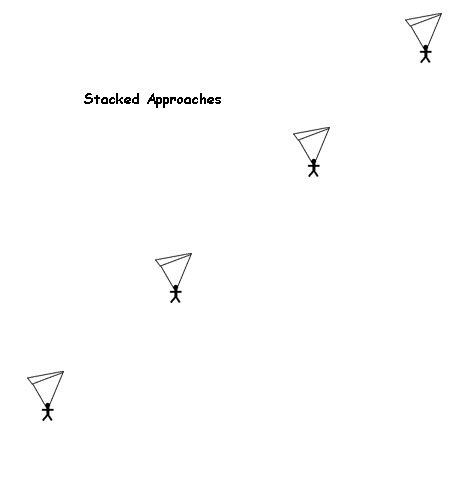
Sample Stacked Approaches
Both classic accuracy and high performance landings require more attention to the ground than surrounding airspace. Stacked exits and approaches allow jumpers to concentrate on their discipline and maintain adequate separation from others while in the air.
CRW Jumps
You must steer with your risers during deployment and keep an eye on those that exit after you. Be prepared to avoid someone with an off-heading, snivelly or delayed opening.
Canopy Traffic Pattern
Check for traffic first and foremost. Then locate the DZ. Determine the pattern and how you will work yourself into it. Carefully maneuver yourself into a position, so that you can safely enter the pattern at 1000 feet AGL. You must check for traffic conflicts during the time you move from your opening position (when doing RW or short delays, CRW jumpers would start this procedure at break-off) to the position you wish to enter the traffic pattern. You should always be looking around to your left, right, above and below, in front of you and behind you.
Canopy traffic patterns are much more complicated than the ones used by aircraft. The canopy traffic pattern includes the airspace from the ground to 1000 ft directly above the landing area plus a 500 foot lateral buffer zone.
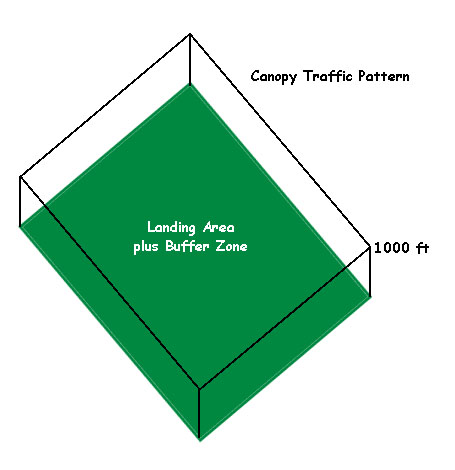
Aircraft all land on the same runways. That means that their final leg is through the same airspace, one after the other. Skydivers have effectively many runways to land on. This means that the canopies do not have to follow each other and land sequentially. It also means that the potential for collisions is much greater if the skydiver 'runways' intersect. It also means that several skydivers can land at the same time when they use parallel 'runways'.

There are times when a skydiver's runway will be identical to other skydivers. Swoop competitions use the same runway for each competitor. The only way this can happen safely is to sequence the approaches and landings of each competitor. The sequencing is achieved by stacked approaches. If two swoopers simultaneously approach a swoop landing area from opposite sides, there is a significant potential for a canopy collision. All swoopers using a common runway must coordinate with other swoopers to ensure clear airspace for each skydiver.
Another complication in skydiver canopy patterns is the fact that there are many different glide slopes. The glide slope is the angle between the horizontal and the glide path of a canopy.
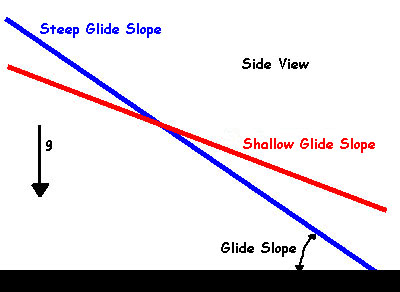
Larger canopies with a low wing loading have a steeper approach compared to smaller canopies with a high wing loading. There will also be all the in-between glide slopes. The amount of wind, and whether you are flying upwind, downwind or crosswind, also changes the glide slope. Speed induced approaches generally have steep glideslopes on final.
Wind speed and direction changes as you descend add more complications to estimating your own glide slope, as well as those of all the other canopies.
Yet another added complication is that skydivers can hold in brakes for awhile, altering their initial glide slope and then change to full flight with a different glide slope.
Standard and Predictable Patterns
The most common standard patterns are the conventional right-hand or left-hand pattern or the straight in pattern. Conventional patterns have all turns in the same direction, i.e. left or right-handed or none at all and the legs are perpendicular to each other (90° turns only). The speed of approach is at most the steady state speed at full flight.
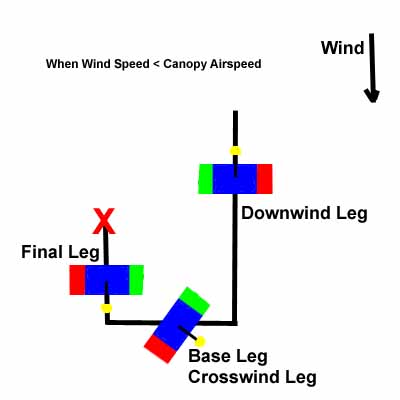
Conventional Right-Hand Pattern
At many DZs, one pattern is preferred and the other pattern is not considered standard at that location. Straight-in patterns are allowed, although not used often, except in long spots. Airports have segmented circles to denote the appropriate pattern for each runway that is followed by aircraft pilots. Many DZs have equivalent rules that detail the appropriate patterns for skydivers.
For instance, suppose a DZ had a North-South runway and the landing area was to the East of the runway. If the landing direction were to the North, then a right-hand pattern would be followed. If the landing direction were to the South, then a left-hand pattern would be followed.
A predictable pattern is one that follows the schematic. It does not have spirals, s-turns or sashays along any leg of the pattern. Deviations from straight legs can cause collisions or cause others to make avoidance maneuvers.
Other standard patterns that have come into common use lately are swoop patterns.
Swoop patterns deviate from conventional patterns in several important ways. One way is that they do not always have a downwind, base and final legs and they do not necessarily have all turns in the same direction. Another way is that speed is induced, so that the trajectory is covered in a much shorter amount of time. The faster speeds mean that the time to react to problems (other traffic or misjudged altitude) is significantly shortened. Many swoop patterns do not have straight legs. Heading changes are done via a continuous turn that usually exceeds 90 degrees. A swoop pattern includes the airspace from the ground to at least 1000 ft directly above the landing area plus a 500 foot lateral margin. A canopy with a large recovery arc requires a higher initiation altitude than a canopy with a smaller recovery arc. Larger turns in a high performance maneuver increase the initiation altitude of the maneuver.
Generally, swoop patterns are best done when there are no other canopies in the pattern because of significant speed differences and pattern entry. Most swoop patterns also need much more airspace for aborted swoops. If a speed inducing maneuver is initiated too low, the swooper must have space to stop the maneuver and land in a different direction.
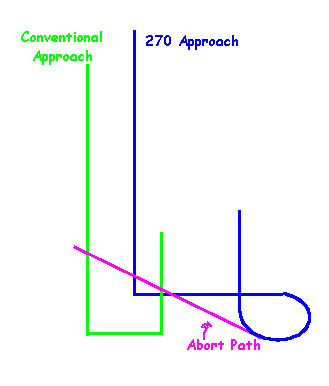
Extra airspace required for aborted 270 approach.
The most compatible swoop patterns with conventional patterns are the front riser and 90 degree approach.
Other swoop patterns, 180s, 270s etc, have been done in conventional patterns with success. But there are many cases of unsuccessful swoop patterns mixed with conventional patterns. Many of these unsuccessful approaches have lead to botched landings or canopy collisions that have resulted in injury or death to jumpers.
One aspect of swoop approaches is dramatically clear. Swoop approaches are much safer and successful when they are done in a dedicated airspace that does not conflict with a conventional or another swoop pattern approach.
It makes sense for jumpers doing swoop patterns to do those approaches away from other traffic, whether it is other swoopers or people flying conventional patterns.
Converging Patterns and Straight-in Approaches
Converging patterns happen when both right-hand and left-hand patterns are used to approach a common landing area. The patterns converge, and have a higher probability of collision on the base leg. This is when skydivers are flying directly at each other and before their turn onto the final leg. It can also cause collisions if a jumper doing a left-hand pattern, flys over to the area that the right-hand pattern jumpers land in. If at all possible, skydivers should use one of the approaches as standard. The other approach should only be used as a last resort or not at all.
Straight-in approaches can also cause potential traffic problems.
Landing Direction
There are a number of common methods used to determine landing direction at DZs. Each DZ has its rules for determining landing direction. These rules may also change based upon special events. Each jumper should learn what the rules are at the DZs they jump at.
Many years ago, the common direction for landing was 'into the wind'. Aircraft land into the wind too. The reason is that the ground speed is minimized and can make for a safer landing. Jumpers could land directly into the wind and would not have to worry about a crosswind component.
On no-wind days, jumpers can pick any direction to land in. This was ok when we all jumped PCs. As canopies became faster and faster, the jumper runway became longer and longer. If a group of jumpers each picked their runway direction, then there was a substantial collision possibility. One way to avoid these intersecting runways was to decide, by some other method, what the landing direction would be.
Some DZs have a rule that may say something to the effect of 'On no-wind or light wind days, land to the North.' The particular direction depends upon the DZ geography and predominant winds. This pre-defined landing direction helped reduce much chaos in landing directions.
Landing areas were still not free of chaos when the winds picked up during the flight to altitude. The prevelent winds may shift 180° from takeoff to landing. Now, a new method was introduced. Another rule of 'The first one down determines the landing direction for the entire load.' This tended to work for awhile. Then some people started landing downwind on purpose. They sometimes were the first ones down. There was an outcry by the people that wanted to land into the wind. Most people wanted to land into the wind, especially when the winds were significant.
More rules were added about what the first one down could or could not do. One of the more common rules is that 'If you land in the main landing area, you must land into the wind.'
Still more problems cropped up, especailly at desert DZs, that had only a relatively small grassey area for landing. These DZs have HUGE deserts to land in, but they only have nice grassy areas over a small portion of the entire DZ.
The rules mutated into something along the lines of 'Landing in the grass in only to the West or to the East and the first person down sets the direction for the entire load.' This plan works well when all jumpers follow it. Each DZ will have its variation on this rule. It will be phrased in terms of their local geography, wind conditions and 'favorite' landing area.
As the rules changed, the problems changed. The latest problem was the high people in the pattern watching for the first one down. If the first one down was doing a high performance approach, they at first looked to be landing in one direction and then suddenly turned and landed in the opposite direction. This caused traffic problems up high. People had to multi-task the watching the first person down as well as the airspace around them. Sometimes the swoopers would 'fool' people closer to the ground. They would commit to landing one way, then only to realize at an altitude too low to turn around in, that the first one down landed in the opposite direction. This continues to be a problem today.
Entering the Canopy Traffic Pattern
Enter the pattern on the downwind leg. There will be many other canopies doing the same thing at various altitudes. You should position yourself with the most distance possible from all of the other canopies. You need to maintain that distance, as much as possible, throughout the downwind, base and final legs of your approach. The separation distance from your nearest neighbors tends to diminish as you get closer to the ground. The patterns by other the jumpers and you tend to converge as you get closer to the ground.
A common technique to establish and confirm visual sighting is to scissor kick your legs. You are saying "I see you, do you see me?" Then the other jumper acknowledges by scissor kicking his legs. The other jumper is saying "Yes, I see you." If a jumper does not scissor kick legs back in response, then assume he does not see you.
Turn to Base Leg
Your turn to base leg should keep the separation that you have created as much as possible. You might turn base before or after someone else that is farther downwind or upwind of you. The idea is to have each person turn base and still have separation. Separation may be horizontal and vertical.
There may be times when you follow someone's glide slope. Be careful not to catch up to them or fly in their canopy's wake. A canopy's wake is the region behind the canopy that has turbulent air. It follows the glide slope and then descends. The length of the wake behind a canopy with significant turbulent air can be as much as ten times the chord of the canopy.
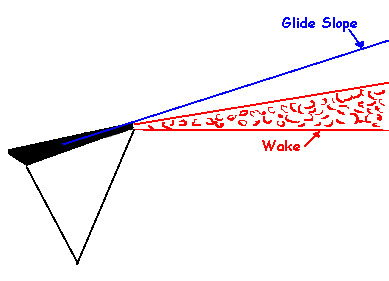
If you have a faster canopy, take a base leg that is offset from their base leg and that will allow you to pass them with sufficient separation. You will also have to make sure your base leg does not conflict with anyone else.
Turn to Final
As with your turn to base, your turn to final should keep the separation that you have created as much as possible. You also have to consider your projected landing point. If you are short of the target, you need to turn sooner. If you are long on the target, you have to turn later. You will have to do this while watching for and avoiding other traffic.
Once you turn to your final direction, it should be in the determined landing direction. Your flight path must be a straight line in the landing direction. This is normally called 'taking a line' (and has nothing to do with drugs). Do not take a line that crosses other people. That is another good way to get into a collision.
It's important to take a definitive line because there may be people that need to pass you on your right or left on final approach. You do not want to do S-turns or sashays because those manuevers may put you on a collision course with someone else.
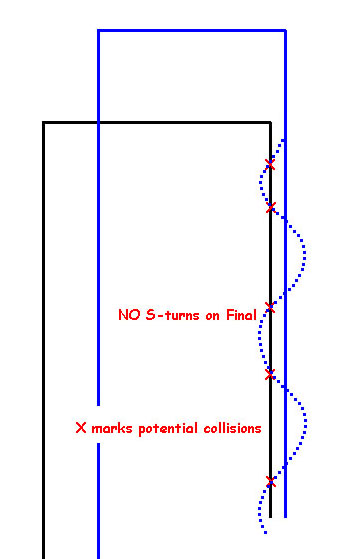
Potential Collisions when someone does S-turns on Final
Aircraft can perform spot landings because they can add power or do slips if they are too low or too high, respectively. Canopies cannot use these exact techniques. Front risers is a way to slip the canopy towards the ground at a higher speed. It can be used to prevent overshooting a target. Slight brake pressure can be use to float somewhat on a target, but is nothing compared to an aircraft that can add power for an undershoot. The best way to avoid undershoot was back when you turned in on your base leg. Undershoots are usually because you take the downwind leg too far downwind.
If you are too high and will overshoot your target, then you can use front risers to descend faster. Be sure to return to steady flight before your flare, unless you are doing a high performance front riser approach.
If you are too low and will under shoot the target, then you might want to add a little bit of brakes to float you further. This is not the best option because people behind you might catch up to you. If it is safe to land short, then do so.
Mixing High Performance and Conventional Patterns
One of the primary causes of canopy collisions in traffic patterns is because the jumpers did not see each other. There are many reasons for this. One of the more popular reasons is that one jumper is doing a high performance approach and another jumper is doing a conventional approach. Another popular reason is that two swoopers are about to execute a HP landing and do not see each other before comitting to the manuever. The best way to avoid these conflicts is to have a stacked landing pattern with no other people in the pattern.
A person doing a conventional approach does not see the high performance jumper because the HP jumper is above and behind the conventional approach jumper, usually in the lower jumper's blind spot. A person doing a high performance approach does not see, prior to executing a HP approach, the lower person. Both jumpers are moving and the airspace to scan is much greater than the actual space the HP jumper will take. The HP jumper needs clear airspace to execute the maneuver plus space for an aborted maneuver.
The HP jumper has to ensure the airspace needed is clear as well as the airspace of people that may enter the required airspace as the HP approach is executed. Not only does the high jumper, about to perform a HP manuever, need to clear his airspace, he also needs to make sure his entry point to the manuever is done with the proper entry speed, direction, altitude and flight control configuration. This is a very high task load for someone about to perform a HP approach with other canopies around. A slight inattention to any one of these requirements can produce a canopy collision or a botched landing. These errors may cause injury or death to the swooper or others.
Separating High Performance and Conventional Patterns
There are two ways to separate high performance and conventional patterns: time and space.
The easiest way to separate the patterns is in space. There is one area for conventional patterns and another area for swoop patterns. If a DZ has the real estate, this is the most feasible solution. The problem that most commonly arises is which group will have the long walk and should be sorted out by the DZ and its customers. More often than not, the swoopers have the long walk or need to shuttle back and forth. This is because there are more conventional pattern pilots than swoop pilots.
Another way to separate the patterns is by time. That is at certain times, swoops are allowed and at other times only conventional patterns are allowed. This happens when a jump plane drops off swoopers at a lower altitude and then continues on up to full altitude for the rest of the load. Care must be taken to educate visiting jumpers about the right time to swoop. They may mistakenly see a swooper and conclude that it is okay to swoop at any time.
There are limitations to the separation in time method. At DZs with only one aircraft, there are no problems. When 2 or more aircraft are flying, the solution becomes more complicated. It is not safe to drop jumpers at a low altitude when the other aircraft is dropping jumpers at full altitude. The DZ has to adhere to a strict timetable that does not drop jumpers at the same time from different aircraft.
What to do if you do collide
Most of the techniques for what to do when you are in a canopy collision come the CRW world.
There are two broad categories for canopy collisions: wraps and entanglements. A wrap is when a parachute is wrapped around a jumper's body. An entanglement is when the parachutes are entangled with each other.
In a wrap scenario, the top jumper's parachute will remain open. Two people under one canopy means thumping-in at twice the normal wing loading. If you have the altitude, the lower jumper cuts away and pulls his reserve. If you do not have the altitude, then riding it in may be the only course of action. The lower jumper could pull his reserve, but that may have problems of inducing a downplane with the other jumper.
An entanglement scenario usually results when one jumper passes through the lines of the other jumper. Both jumpers may have to cut away and pull their reserves. The top person cuts away first so that the line recoil does not wrap the other jumper. It is possible that the cutaway canopy may free itself from the lower jumper's canopy. If an entanglement is spinning, then the higher, spinner jumper should cutaway first.
Collisions in the traffic pattern are incidents that require immediate action. There usually will not be time to talk to the other jumper. It is a dicey situation to cutaway below 1000 feet. Canopy collisions within the traffic pattern are very dangerous. Probably the best thing to do is pull the reserve and hope that you get more nylon above your head.
The way to avoid canopy collisions is to maintain canopy separation at all times. That should be everyone's goal on every jump.